Influence of Planting and Irrigation Levels as Physical Methods on Maize Root Morphological Traits, Grain Yield and Water Productivity in Semi-Arid Region
Abstract
1. Introduction
2. Materials and Methods
2.1. Study Location Details
2.2. Experimental Details
2.3. Irrigation Scheduling
2.4. Root Observation
2.5. Maize Yield Parameters
2.6. Water Productivity
2.7. Data Analysis
3. Results and Discussion
3.1. Effect of Planting Methods and Irrigation Levels on Maize Root Morphology
3.1.1. Root Length, Surface Area, Volume and Number of Tips
3.1.2. Root Forks, Crown Roots, Shoot and Root Dry Weight
3.1.3. Root Length and Weight Density, and Root to Shoot Ratio
3.1.4. Root Diameter and Brace Root Numbers
3.2. Grain and Stover Yield
3.3. Water Productivity
4. Conclusions
Supplementary Materials
Author Contributions
Funding
Institutional Review Board Statement
Informed Consent Statement
Data Availability Statement
Acknowledgments
Conflicts of Interest
References
- Grant, R.F. Simulation in ecosys of root growth response to contrasting soil water and nitrogen. Ecol. Model. 1998, 107, 237–264. [Google Scholar] [CrossRef]
- Khan, M.A.; Gemenet, D.C.; Villordon, A. Root system architecture and abiotic stress tolerance: Current knowledge in root and tuber crops. Front. Plant Sci. 2016, 7, 1584. [Google Scholar] [CrossRef]
- Bardgett, R.D.; Mommer, L.; DeVries, F.T. Going underground: Root traits as drivers of ecosystem processes. Trends Ecol. Evol. 2014, 29, 692–699. [Google Scholar] [CrossRef]
- Rillig, M.C.; Aguilar-Trigueros, C.A.; Bergmann, J.; Verbruggen, E.; Veresoglou, S.D.; Lehmann, A. Plant root and mycorrhizal fungal traits for understanding soil aggregation. New Phytol. 2015, 205, 1385–1388. [Google Scholar] [CrossRef] [PubMed]
- Erktan, A.; McCormack, M.L.; Roumet, C. Frontiers in root ecology: Recent advances and future challenges. Plant Soil 2018, 424, 1–9. [Google Scholar] [CrossRef]
- Heinze, S.; Ludwig, B.; Piepho, H.P.; Mikutta, R.; Don, A.; Wordell-Dietrich, P.; Helfrich, M.; Hertel, D.; Leuschner, C.; Kirfel, K.; et al. Factors controlling the variability of organic matter in the top- and subsoil of a sandy Dystric Cambisol under beech forest. Geoderma 2018, 311, 37–44. [Google Scholar] [CrossRef]
- McCormack, M.L.; Dickie, I.A.; Eissenstat, D.M.; Fahey, T.J.; Fernandez, C.W.; Guo, D.; Helmisaari, H.S.; Hobbie, E.A.; Iversen, C.M.; Jackson, R.B.; et al. Redefining fine roots improves understanding of below-ground contributions to terrestrial biosphere processes. New Phytol. 2015, 207, 505–518. [Google Scholar] [CrossRef] [PubMed]
- Liu, L.P.; Gan, Y.T.; Bueckert, R.; Rees, V.K. Rooting systems of oilseed and pulse crops I: Temporal growth patterns across the plant developmental periods. Field Crop. Res. 2011, 122, 256–263. [Google Scholar] [CrossRef]
- Sainju, U.M.; Singh, B.P.; Rahman, S.; Reddy, V.R. Tomato root growth is influenced by tillage, cover cropping, and nitrogen fertilization. Hort. Sci. 2000, 35, 78–82. [Google Scholar] [CrossRef]
- Khan, M.B.; Rafiq, R.; Hussain, M.; Farooq, M.; Jabran, K. Ridge sowing improves root system, phosphorus uptake, growth and yield of maize (Zea mays L.) hybrids. Measurements 2012, 22, 309–317. [Google Scholar]
- Anderson, E.L. Corn root growth and distribution as influenced by tillage and nitrogen fertilization. Agron. J. 1987, 79, 544–549. [Google Scholar] [CrossRef]
- Singh, K.K.; Srinivasarao, C.; Ali, M. Root growth, nodulation, grain yield, and phosphorus use efficiency of lentil as influenced by phosphorus, irrigation, and inoculation. Commun. Soil Sci. Plant Anal. 2005, 36, 1919–1929. [Google Scholar] [CrossRef]
- Iwama, K.; Hukushima, T.; Yoshimura, T.; Nakaseko, K. Influence of planting density on root growth and yield in potato. Jpn. J. Crop Sci. 1993, 62, 628–635. [Google Scholar] [CrossRef][Green Version]
- Food and Agriculture Organization of the United Nations. Crop Prospects and Food Situation. Available online: http://www.fao.org/3/I9666EN/i9666en.pdf (accessed on 20 August 2020).
- Sangakkara, U.R.; Amarasekera, P.; Stamp, P. Irrigation regimes affect early root development, shoot growth and yields of maize (Zea mays L.) in tropical minor seasons. Plant Soil Environ. 2010, 56, 228–234. [Google Scholar]
- Sah, R.P.; Chakraborty, M.; Prasad, K.; Pandit, M.; Tudu, V.K.; Chakravarty, M.K.; Narayan, S.C.; Rana, M.; Moharana, D. Impact of water deficit stress in maize: Phenology and yield components. Sci. Rep. 2020, 10, 2944. [Google Scholar] [CrossRef] [PubMed]
- Mitchell, W.H.; Sparks, D.L. Influence of subsurface irrigation and organic additions on top and root growth of field corn. Agron. J. 1982, 74, 1084–10818. [Google Scholar] [CrossRef]
- Materechera, S.A.; Mloza-Banda, H.R. Soil penetration resistance, root growth and yield of maize as influenced by tillage system on ridges in Malawi. Soil Tillage Res. 1997, 41, 13–24. [Google Scholar] [CrossRef]
- Khan, M.B.; Yousaf, F.; Hussain, M.; Haq, M.W.; Lee, D.J.; Farooq, M. Influence of planting methods on root development, crop productivity and water use efficiency in maize hybrids. Chil. J. Agric. Res. 2012, 72, 556–563. [Google Scholar] [CrossRef]
- Wadile, S.C.; Solanke, A.V.; Tumbhare, A.D.; Ilhe, S.S. Influence of land configuration and nutrient management on yield, quality and economics of soybean (Glycine max)–sweet corn (Zea mays) cropping sequence. Indian J. Agron. 2017, 62, 141–146. [Google Scholar]
- Halli, H.M.; Angadi, S.S. Influence of land configuration and deficit irrigation on nutrient uptake and grain yield of maize (Zea mays L.). J. Farm Sci. 2019, 32, 397–402. [Google Scholar]
- Kiran, J.A.; Lingaraju, B.S.; Ananda, N. Effect of in situ moisture conservation practices and nitrogen levels on growth, yield and economics of rabi sorghum under rainfed condition. Crop Res. 2008, 35, 13–16. [Google Scholar]
- Zentner, R.P.; Wall, D.D.; Nagy, C.N.; Smith, E.G.; Young, D.L.; Miller, P.R.; Campbell, C.A.; McConkey, B.G.; Brandt, S.A.; Lafond, G.P.; et al. Economic crop diversification and tillage opportunities in the Canadian prairies. Agron. J. 2002, 94, 216–230. [Google Scholar] [CrossRef]
- Gao, Y.; Xie, Y.; Jiang, H.; Wu, B.; Niu, J. Soil water status and root distribution across the rooting zone in maize with plastic film mulching. Field Crop. Res. 2014, 156, 40–47. [Google Scholar] [CrossRef]
- Jama, A.O.; Ottman, M.J. Timing of the first irrigation in corn and water stress conditioning. Agron. J. 1993, 85, 1159–1164. [Google Scholar] [CrossRef]
- Cakir, R. Effect of water stress at different development stages on vegetative and reproductive growth of corn. Field Crop. Res. 2004, 89, 1–6. [Google Scholar] [CrossRef]
- Doorenbos, J.; Kassam, A.H. Yield response to water. Irrig. Drain. Pap. 1979, 33, 257. [Google Scholar]
- Igbadun, H.E.; Tarimo, A.K.P.R.; Salim, B.A.; Mahoo, H.F. Evaluation of selected crop water production functions for an irrigated maize crop. Agric. Water Manag. 2007, 94, 1–10. [Google Scholar] [CrossRef]
- Li, C.; Sun, J.; Li, F.; Zhou, X.; Li, Z.; Qiang, X.; Guo, D. Response of root morphology and distribution in maize to alternate furrow irrigation. Agric. Water Manag. 2011, 98, 1789–1798. [Google Scholar] [CrossRef]
- Kang, S.; Shi, W.; Zhang, J. An improved water-use efficiency for maize grown under regulated deficit irrigation. Field Crop. Res. 2000, 67, 207–214. [Google Scholar] [CrossRef]
- Sampathkumar, T.; Pandian, B.J.; Mahimairaja, S. Soil moisture distribution and root characters as influenced by deficit irrigation through drip system in cotton-maize cropping sequence. Agric. Water Manag. 2012, 103, 43–53. [Google Scholar] [CrossRef]
- Ahmed, A.; Alfalahi, H.M.; Al-Abodi, K.; Bassam, K.; Jabbar, A.; Amer, M.M.; Khiadher, A.S. Scheduling irrigation as a water saving practice for corn (Zea mays L.) production in Iraq. Int. J. Appl. Agric. Sci. 2015, 1, 55–59. [Google Scholar]
- Dikey, H.H.; Bhale, V.M.; Kale, V.S.; Wankhade, R.S. Effect of land configuration, irrigation level and nutrient management on growth, yield and economics of turmeric (Curcuma longa L.). Int. J. Curr. Microbiol. Appl. Sci. 2019, 8, 2306–2322. [Google Scholar] [CrossRef]
- Government of India. Agricultural Statistics at a Glance. 2018. Available online: www.agricoop.nic.in; http://eands.dacnet.nic.in (accessed on 20 September 2020).
- Michael, A.M. Irrigation Theory and Practice; Vikas Publishing House; Private Ltd.: New Delhi, India, 2009; p. 302. [Google Scholar]
- Martin, D.L.; Stegman, E.C.; Freres, E. Irrigation scheduling principals. In Management of Farm Irrigation Systems; Hoffman, G.L., Howell, T.A., Solomon, K.H., Eds.; ASAE Monograph: St. Joseph, MO, USA, 1990; pp. 155–372. [Google Scholar]
- Li, J.; Ji, H.; Li, B.; Liu, Y. Wetting patterns and nitrate distributions in layered-textural soils under drip irrigation. J. Agric. Sci. China 2007, 6, 970–980. [Google Scholar] [CrossRef]
- Amos, B.; Walters, D.T. Maize root biomass and net rhizodeposited carbon. Soil Sci. Soc. Am. J. 2006, 70, 1489–1503. [Google Scholar] [CrossRef]
- Tariq, J.A.; Usman, K. Regulated deficit irrigation scheduling on maize crop. Sarhad J. Agric. 2009, 25, 441–450. [Google Scholar]
- Saini, H.S.; Westgate, M.E. Reproductive development in grain crops during drought. Adv. Agron. 1999, 68, 59–96. [Google Scholar]
- Hebbi, B.S. Influence of in Situmoisture Conservation Practices in Sun Hemp Green Manuring and Levels of Nitrogen on rabi Sorghum. Ph.D. Thesis, University of Agricultural Sciences, Dharwad, Karnataka, India, 2000. [Google Scholar]
- Li, Q.M.; Liu, B.B. Comparison of three methods for determination of root hydraulic conductivity of maize (Zea mays L.) root system. Agric. Sci. China 2010, 9, 1438–1447. [Google Scholar] [CrossRef]
- Costa, C.; Dwyer, L.M.; Hamilton, R.I.; Hamel, C.; Nantais, L.; Smith, D.L. A sampling method for measurement of large root systems with scanner-based image analysis. Agron. J. 2000, 92, 621–627. [Google Scholar] [CrossRef]
- Shete, P.G.; Baviskar, V.S.; Adhav, S.L. Effect of land configuration, inorganic fertilizers and levels of FYM on quality and nutrient status of rabi greengram. Int. J. Agric. Sci. 2010, 6, 546–548. [Google Scholar]
- Taisheng, D.; Kang, D.; Sun, J.; Zhang, X.; Zhang, J. An improved water use efficiency of cereals under temporal and spatial deficit irrigation in north China. Agric. Water Manag. 2010, 97, 66–74. [Google Scholar]
- Nassiri, S.M.; Sepaskhah, A.R.; Maharlooei, M.M. The effect of planting methods on maize growth and yield at different irrigation regimes. Iran Agric. Res. 2016, 35, 27–32. [Google Scholar]
- Halli, H.M.; Angadi, S.S. Response of land configuration and deficit irrigation on growth and yield attributes of maize (Zea mays L.). Int. J. Curr. Microbiol. Appl. Sci. 2017, 6, 52–60. [Google Scholar] [CrossRef][Green Version]
- Fusheng, L.; Jihua, L.; Shaozhong, K.; Jianhua, Z. Benefits of alternate partial root-zone irrigation on growth, water and nitrogen use efficiencies modified by fertilization and soil water status in maize. Plant Soil 2007, 295, 279–291. [Google Scholar]
- Gheysari, M.; Sayed, H.S.; Henry, W.L.; Samia, A.; Mohammad, J.Z.; Mohammad, M.M.; Parvaneh, A.; Jose, O.P. Comparison of deficit irrigation management strategies on root, plant growth and biomass productivity of silage maize. Agric. Water Manag. 2017, 182, 126–138. [Google Scholar] [CrossRef]
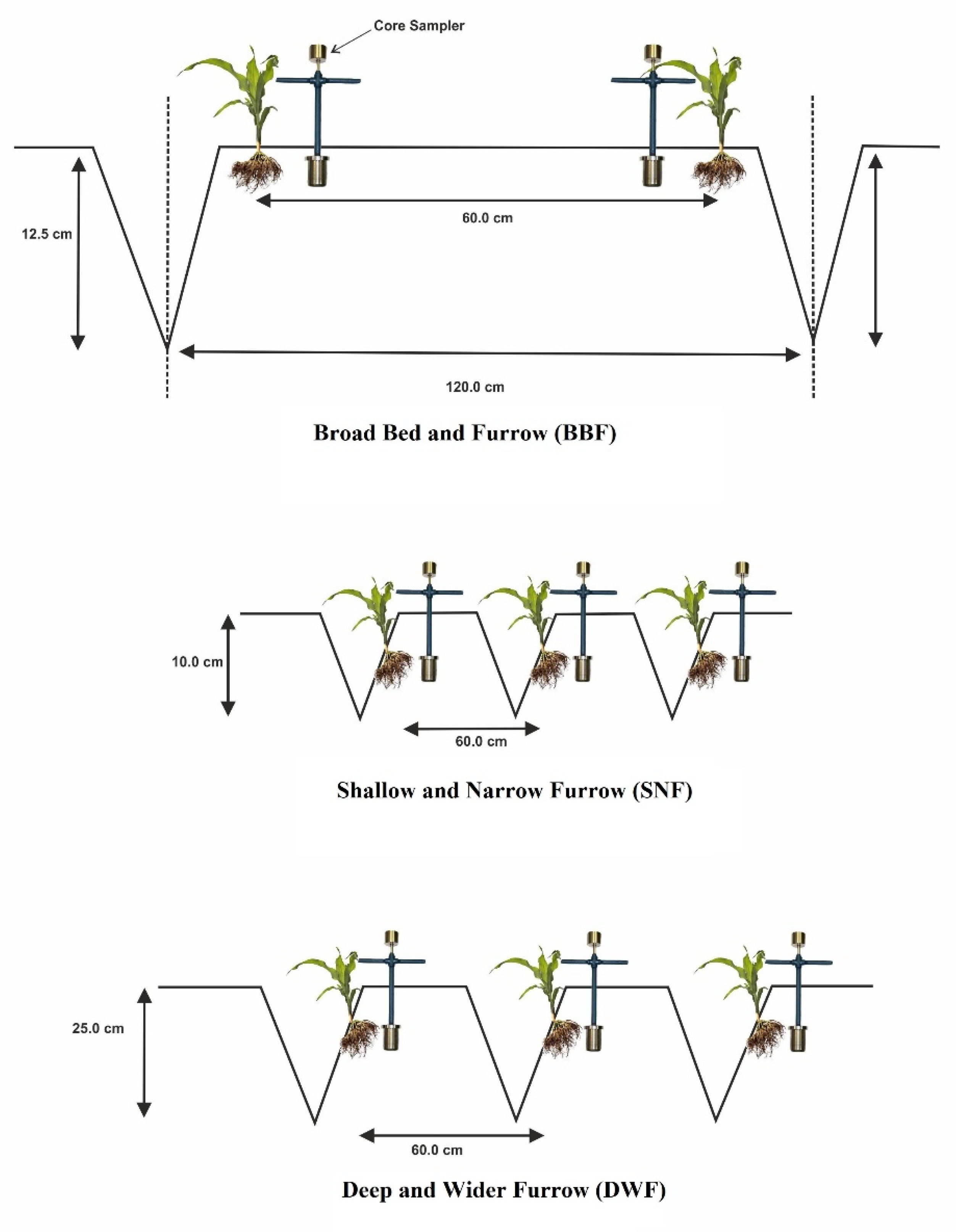
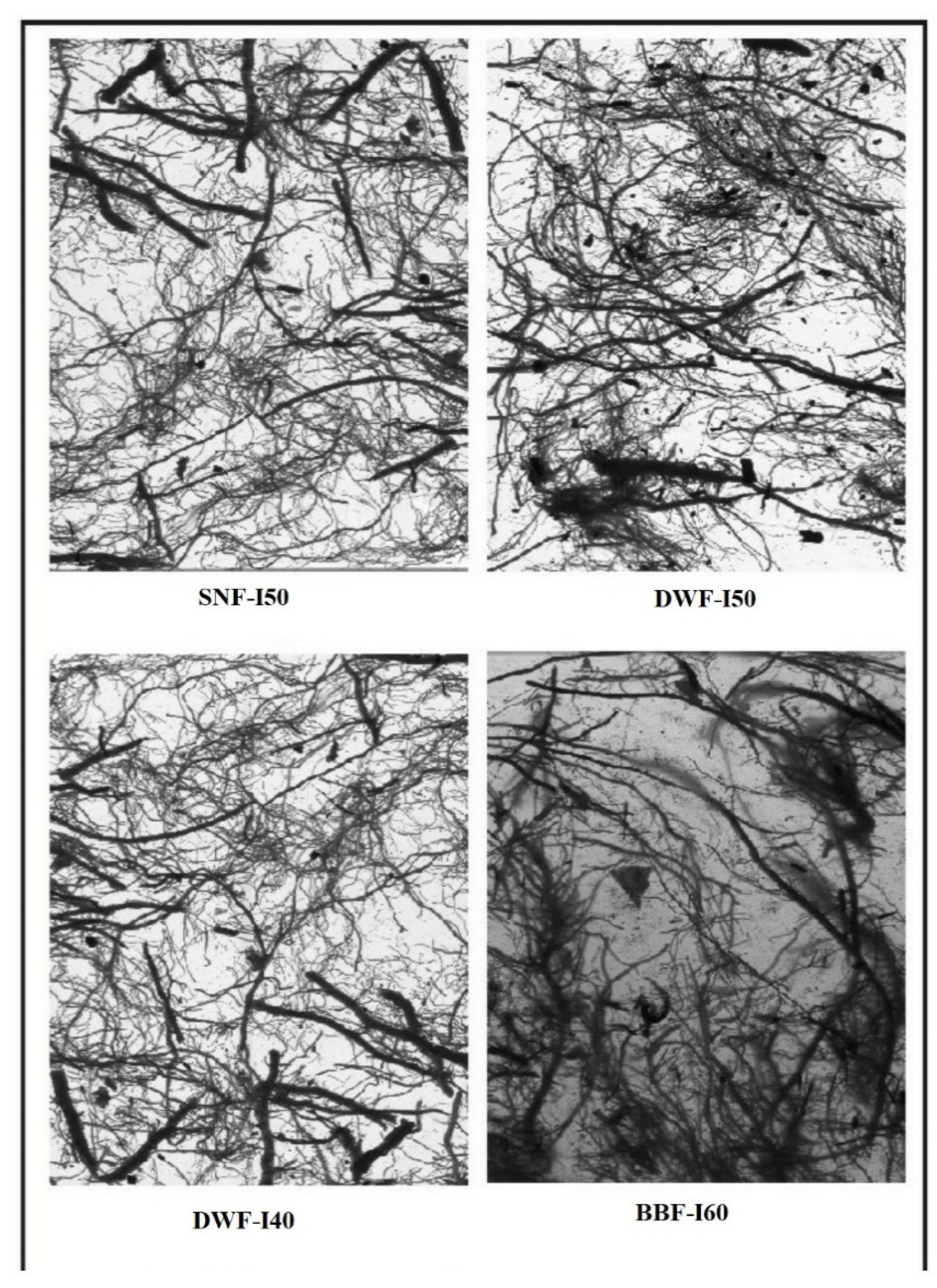
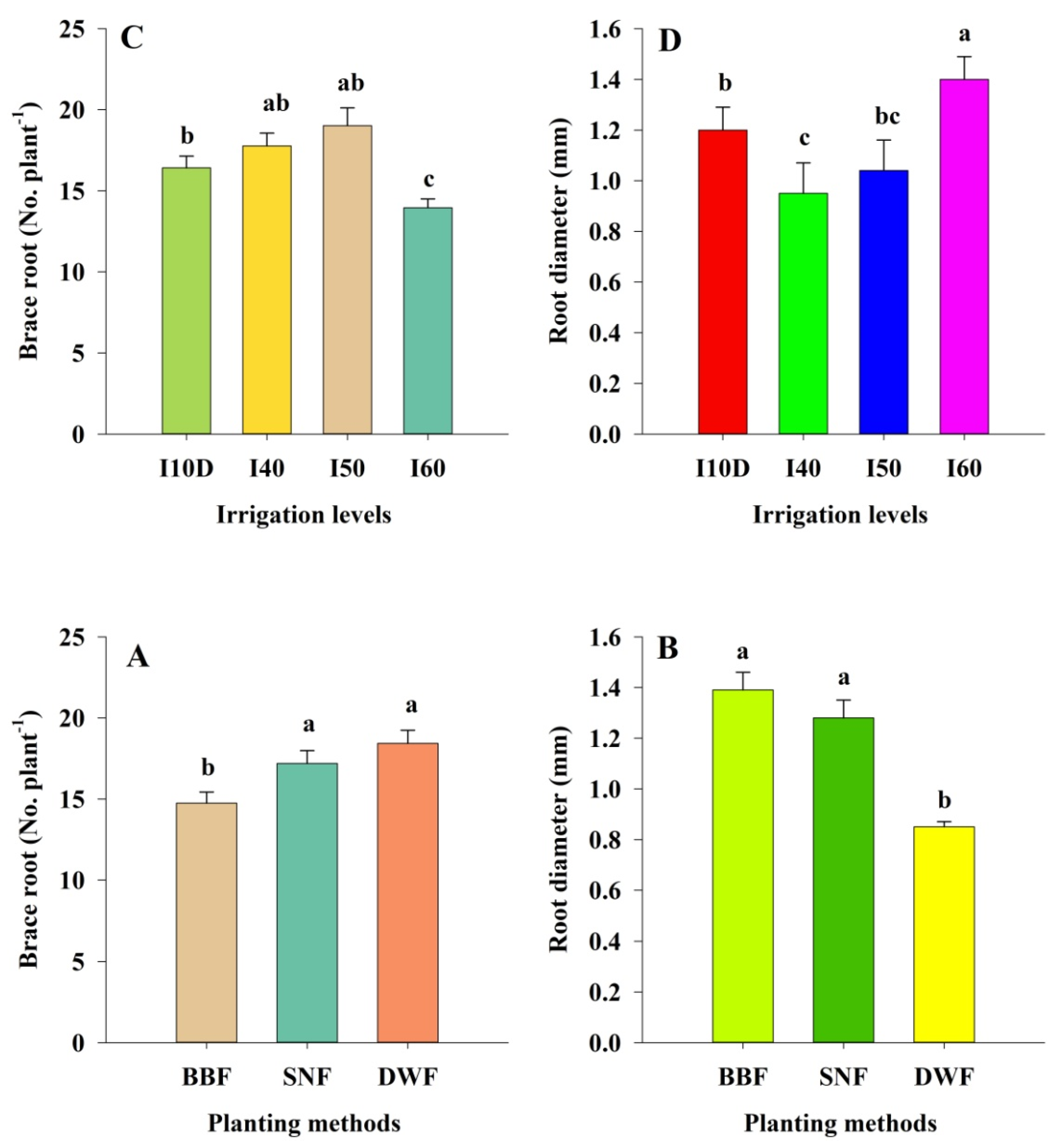
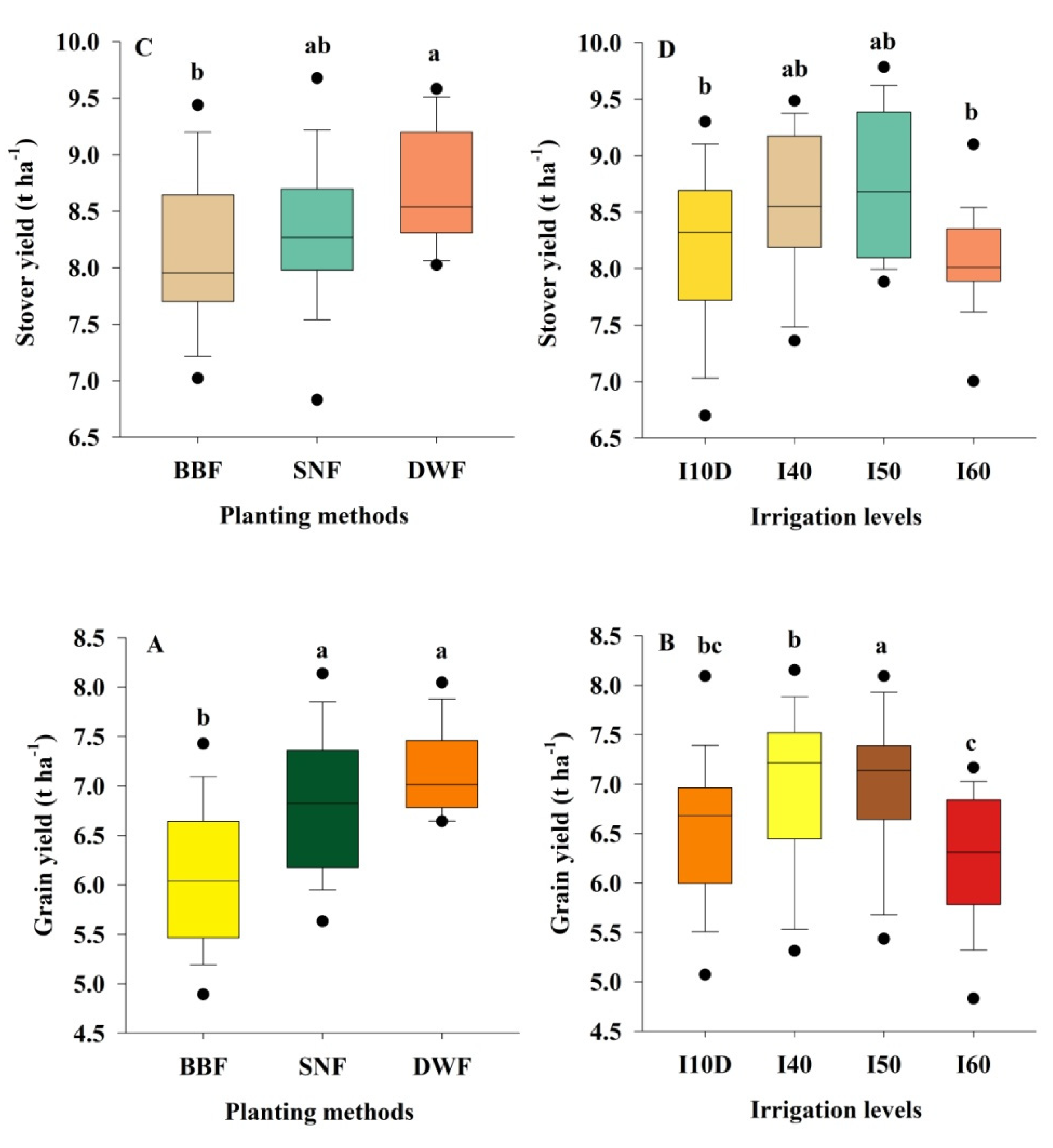
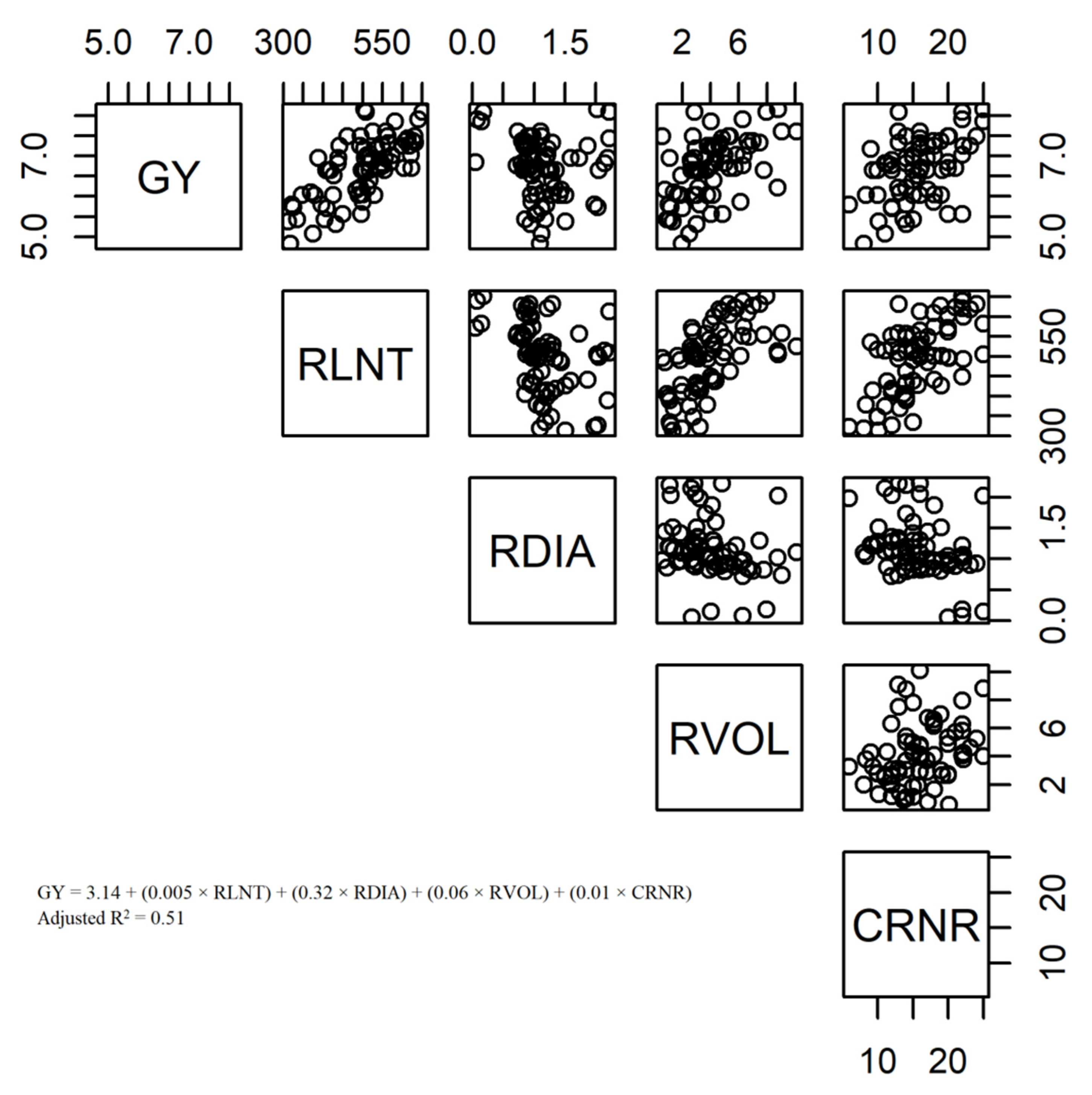
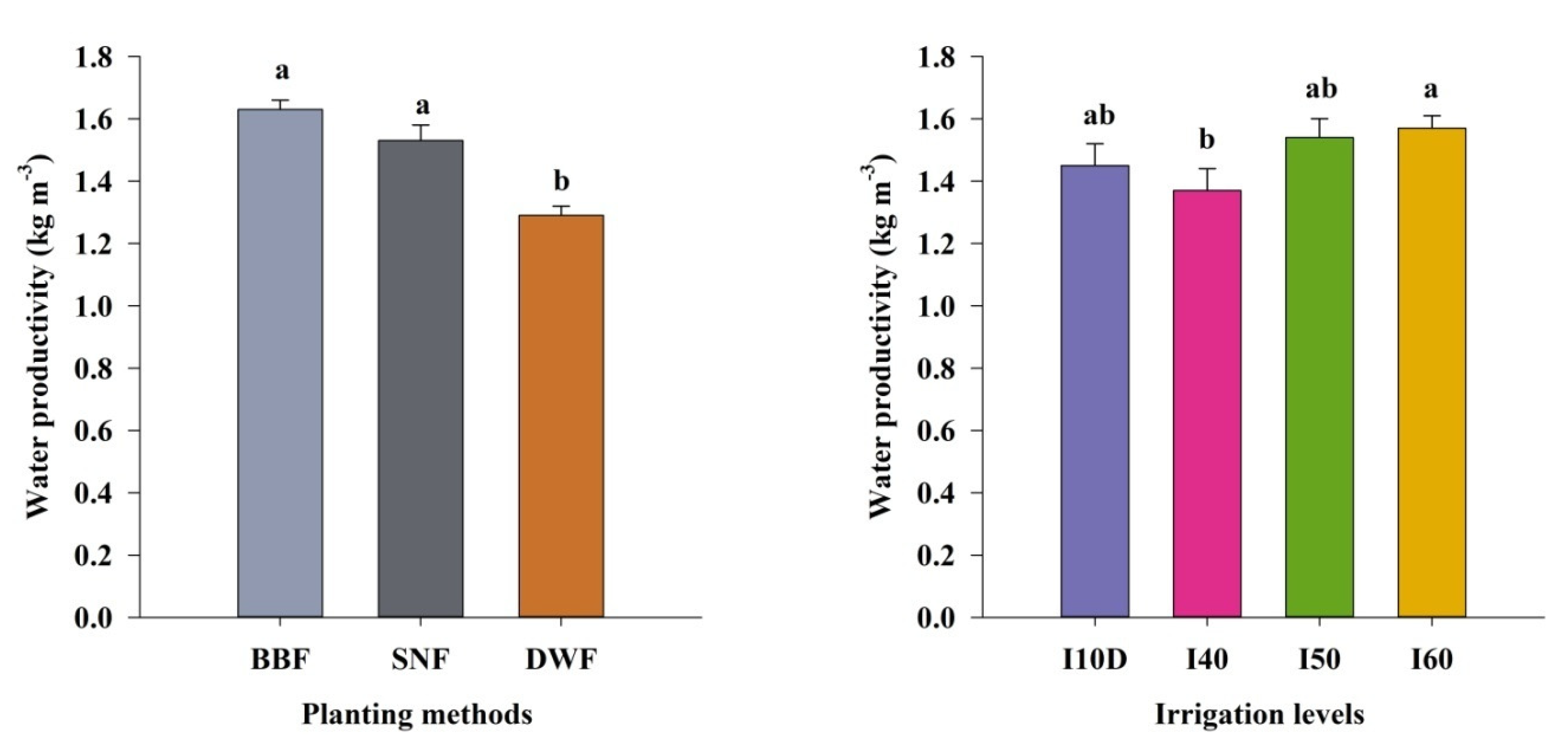
| Crop Stage (DAS *) | 2015 | 2016 | ||||
|---|---|---|---|---|---|---|
| Max. Temp (°C) | Min. Temp (°C) | Rainfall (mm) | Max. Temp (°C) | Min. Temp (°C) | Rainfall (mm) | |
| 0–15 (Feb 1FN *) | 30.9 | 13.9 | 0.0 | 32.6 | 16.2 | 0.0 |
| 15–30 (Feb IIFN) | 32.9 | 15.4 | 0.0 | 34.7 | 19.6 | 0.2 |
| 30–45 (Mar IFN) | 31.5 | 18.2 | 105 | 35.3 | 20.3 | 0.0 |
| 45–60 (Mar IIFN) | 34.8 | 20.4 | 0.2 | 37.0 | 20.9 | 2.4 |
| 60–75 (Apr IFN) | 34.6 | 19.9 | 0.0 | 37.5 | 21.6 | 8.6 |
| 75–90 (Apr IIFN) | 35.5 | 20.8 | 13.2 | 38.6 | 21.7 | 11.8 |
| 90–105 (May IFN) | 35.4 | 21.3 | 91.0 | 38.3 | 21.4 | 61.0 |
| 105–120 (May IIFN) | 34.0 | 22.4 | 38.4 | 33.9 | 22.5 | 21.8 |
| Treatments * | Irrigation Applied (mm) | Total Water (mm) |
|---|---|---|
| Planting method | ||
| BBF | 260.4 | 372.5 |
| SNF | 341.9 | 454.0 |
| DWF | 440.6 | 552.9 |
| Irrigation level | ||
| I10D | 347.7 | 459.8 |
| I40 | 405.3 | 517.7 |
| I50 | 347.7 | 459.8 |
| I60 | 289.8 | 401.8 |
| Variance * | DF | RLNT | RDIA | RSFA | RVOL | RTIP | RFOR | CRNR | BRCR | SHDW | RTDW | RSRT | RLD | RWD | GRY | STY | WP |
|---|---|---|---|---|---|---|---|---|---|---|---|---|---|---|---|---|---|
| PM | 2 | <0.0001 | <0.0001 | <0.0001 | <0.0001 | <0.0001 | <0.0001 | <0.0001 | 0.0001 | <0.0001 | <0.0001 | <0.0001 | <0.0001 | <0.0001 | <0.0001 | 0.0047 | <0.0001 |
| IL | 3 | <0.0001 | <0.0001 | <0.0001 | <0.0001 | <0.0001 | <0.0001 | <0.0001 | <0.0001 | <0.0001 | <0.0001 | <0.0001 | <0.0001 | <0.0001 | <0.0001 | 0.0066 | 0.0019 |
| PM × IL | 6 | <0.0001 | NS | <0.0001 | <0.0001 | <0.0001 | <0.0001 | 0.0363 | NS | 0.0004 | 0.0002 | <0.0001 | <0.0001 | 0.0002 | <0.0500 | NS | NS |
| Treatment * | Root Length (cm Plant–1) | Root Surface Area (cm2 Plant–1) | Root Volume (cm3 Plant–1) | Root Tips Plant–1 | |
|---|---|---|---|---|---|
| Planting methods | |||||
| BBF | 393.5 (±13.15 **) c | 115.4 (±1.92) c | 2.65 (±0.32) c | 2587 (±225) c | |
| SNF | 531.6 (±14.35) b | 136.68 (±6.62) b | 4.48 (±0.45) b | 3091 (±321) b | |
| DWF | 566.7 (±12.76) a | 168.8 (±4.57) a | 5.03 (±0.40) a | 4887 (±610) a | |
| p value | <0.0001 | <0.0001 | <0.0001 | <0.0001 | |
| Irrigation levels | |||||
| I10D | 483.4 (±25.37) c | 133.2 (±8.46) c | 3.73 (±0.53) b | 2961 (±146) c | |
| I40 | 504.1 (±17.63) b | 138.7 (±7.35) b | 4.93 (±0.39) a | 3614 (±139) b | |
| I50 | 554.7 (±34.13) a | 161.9 (±10.73) a | 4.88 (±0.62) a | 5342 (±780) a | |
| I60 | 446.9 (±30.16) d | 127.4 (±6.25) d | 2.68 (±0.36) c | 2171 (±345) d | |
| p value | <0.0001 | <0.0001 | <0.0001 | <0.0001 | |
| Interaction effect | |||||
| BBF | I10D | 386.2 (±4.31) j | 110.0 (±2.13) e | 2.09 (±0.59) g | 2716 (±0.57) h |
| I40 | 441.9 (±4.28) h | 121.6 (±2.14) de | 3.80 (±0.54) de | 3127 (±0.66) f | |
| I50 | 418.8 (±4.31) i | 120.1 (±1.55) de | 2.77 (±0.54) f | 3175 (±0.66) f | |
| I60 | 326.9 (±4.39) k | 109.9 (±3.19) e | 1.94 (±0.55) g | 1331 (±0.57) k | |
| SNF | I10D | 507.3 (±4.09) f | 123.8 (±1.70) d | 4.10 (±0.54) d | 2623 (±0.57) i |
| I40 | 507.3 (±4.39) f | 126.8 (±1.70) d | 5.47 (±0.54) bc | 3621 (±1.20) d | |
| I50 | 613.2 (±4.10) b | 174.5 (±1.02) b | 5.72 (±0.73) ab | 4481 (±1.15) b | |
| I60 | 498.4 (±4.21) g | 121.6 (±0.93) de | 2.63 (±0.54) f | 1641 (±28.3) j | |
| DWF | I10D | 556.3 (±3.86) d | 165.7 (±3.17) b | 4.99 (±0.73) c | 3546 (±1.15) e |
| I40 | 563.1 (±4.21) c | 167.7 (±2.22) b | 5.51 (±0.54) b | 4093 (±1.15) c | |
| I50 | 632.0 (±4.18) a | 191.1 (±0.51) a | 6.14 (±0.73) a | 8370 (±1.20) a | |
| I60 | 515.4 (±4.39) e | 150.5 (±4.80) c | 3.49 (±0.59) e | 3542 (±1.15) e | |
| p value | <0.0001 | <0.0001 | <0.0001 | <0.0001 | |
| Treatment * | Root Forks Plant−1 | Crown Roots Plant−1 | Shoot Dry Weight (g Plant−1) | Root Dry Weight (g Plant−1) | |
|---|---|---|---|---|---|
| Planting methods | |||||
| BBF | 3223 (±181 **) c | 12.89 (±0.81) b | 59.34 (±0.75) c | 9.24 (±0.54) b | |
| SNF | 5852 (±351) b | 17.17 (±0.72) a | 65.64 (±2.32) b | 13.89 (±1.25) a | |
| DWF | 8508 (±415) a | 17.26 (±0.98) a | 72.71 (±1.60) a | 14.64 (±1.22) a | |
| p value | <0.0001 | <0.0001 | <0.0001 | <0.0001 | |
| Irrigation levels | |||||
| I10D | 5416 (±721) c | 14.53 (±0.74) b | 61.99 (±1.47) c | 11.22 (±0.61) c | |
| I40 | 6642 (±838) b | 17.45 (±0.89) a | 67.86 (±2.10) b | 13.36 (±0.93) b | |
| I50 | 7019 (±891) a | 17.95 (±1.35) a | 72.29 (±2.78) a | 16.77 (±1.76) a | |
| I60 | 4366 (±602) d | 13.17 (±0.92) b | 61.44(±2.49) c | 9.01 (±0.72) d | |
| p value | <0.0001 | <0.0001 | <0.0001 | <0.0001 | |
| Interaction effect | |||||
| BBF | I10D | 2950 (±6.83) k | 12.08 (±1.01) de | 57.26 (±0.13) d | 9.34 (±1.05) de |
| I40 | 3641 (±6.83) j | 15.83 (±1.62) b–d | 62.14 (±0.87) cd | 10.37 (±0.43) b–d | |
| I50 | 3923 (±6.83) i | 13.50 (±1.01) c–e | 61.24 (±0.58) cd | 9.91 (±1.15) de | |
| I60 | 2378 (±7.17) l | 10.17 (±1.11) e | 56.71 (±0.34) d | 7.34 (±1.05) e | |
| SNF | I10D | 5351 (±6.66) g | 16.51 (±0.77) b–d | 61.63 (±1.05) cd | 11.94 (±0.62) b–d |
| I40 | 6843 (±6.83) e | 18.17 (±2.19) a–c | 66.84 (±0.28) bc | 14.01 (±0.54) bc | |
| I50 | 7033 (±6.83) d | 18.51 (±1.61) ab | 77.32 (±0.93) a | 20.21 (±0.41) a | |
| I60 | 4179 (±6.83) h | 15.51 (±0.78) b–d | 56.77 (±0.44) d | 9.41 (±1.26) de | |
| DWF | I10D | 7946 (±6.83) c | 15.01 (±0.02) b–d | 67.08 (±0.86) bc | 12.37 (±0.62) b–d |
| I40 | 9442 (±11.83) b | 18.34 (±0.43) ab | 74.60 (±3.59) a | 15.71 (±1.58) b | |
| I50 | 10102 (±6.66) a | 21.84 (±0.91) a | 78.30 (±0.15) a | 20.21 (±0.70) a | |
| I60 | 6541 (±6.66) f | 13.84 (±0.95) b–e | 70.85 (±2.84) ab | 10.27 (±1.16) c–e | |
| p value | <0.0001 | 0.0363 | 0.0004 | 0.0002 | |
| Treatment * | Root Length Density (cm cm−3) | Root Weight Density (mg cm−3) | Root to Shoot Ratio | |
|---|---|---|---|---|
| Planting methods | ||||
| BBF | 0.52 (±0.01 **) c | 12.25 (±0.71) b | 0.13 (±0.01) c | |
| SNF | 0.67 (±0.01) b | 18.51 (±1.61) a | 0.20 (±0.02) b | |
| DWF | 0.78 (±0.01) a | 19.41 (±1.62) a | 0.25 (±0.02) a | |
| p value | <0.0001 | <0.0001 | <0.0001 | |
| Irrigation levels | ||||
| I10D | 0.64 (±0.03) c | 14.87 (±0.82) c | 0.16 (±0.01) c | |
| I40 | 0.68(±0.03) b | 17.72 (±1.23) b | 0.21 (±0.01) b | |
| I50 | 0.70 (±0.03) a | 22.24 (±2.34) a | 0.28 (±0.03) a | |
| I60 | 0.61 (±0.04) d | 12.07 (±0.92) d | 0.14 (±0.01) c | |
| p value | <0.0001 | <0.0001 | <0.0001 | |
| Interaction effect | ||||
| BBF | I10D | 0.51 (±0.01) j | 12.38 (±1.40) de | 0.15 (±0.01) de |
| I40 | 0.55 (±0.01) i | 13.75 (±0.56) c–e | 0.17 (±0.02) cd | |
| I50 | 0.59 (±0.01) h | 13.13 (±1.52) de | 0.12 (±0.01) de | |
| I60 | 0.43 (±0.01) k | 9.73 (±1.40) e | 0.10 (±0.01) e | |
| SNF | I10D | 0.67 (±0.01) f | 15.83 (±0.83) b–d | 0.12 (±0.01) de |
| I40 | 0.68 (±0.01) e | 18.57 (±0.72) bc | 0.23 (±0.02) b | |
| I50 | 0.67 (±0.01) f | 26.80 (±0.55) a | 0.35 (±0.01) a | |
| I60 | 0.66 (±0.01) g | 12.85 (±1.31) de | 0.12 (±0.01) de | |
| DWF | I10D | 0.75 (±0.01) c | 16.41 (±0.83) b–d | 0.20 (±0.01) bc |
| I40 | 0.81 (±0.01) b | 20.83 (±2.09) b | 0.25 (±0.01) b | |
| I50 | 0.84 (±0.01) a | 26.80 (±0.93) a | 0.36 (±0.01) a | |
| I60 | 0.74 (±0.01) d | 13.62 (±1.55) c–e | 0.19 (±0.01) bc | |
| p value | <0.0001 | 0.0002 | <0.0001 | |
Publisher’s Note: MDPI stays neutral with regard to jurisdictional claims in published maps and institutional affiliations. |
© 2021 by the authors. Licensee MDPI, Basel, Switzerland. This article is an open access article distributed under the terms and conditions of the Creative Commons Attribution (CC BY) license (http://creativecommons.org/licenses/by/4.0/).
Share and Cite
Halli, H.M.; Angadi, S.; Kumar, A.; Govindasamy, P.; Madar, R.; El-Ansary, D.O.; Rashwan, M.A.; Abdelmohsen, S.A.M.; Abdelbacki, A.M.M.; Mahmoud, E.A.; et al. Influence of Planting and Irrigation Levels as Physical Methods on Maize Root Morphological Traits, Grain Yield and Water Productivity in Semi-Arid Region. Agronomy 2021, 11, 294. https://doi.org/10.3390/agronomy11020294
Halli HM, Angadi S, Kumar A, Govindasamy P, Madar R, El-Ansary DO, Rashwan MA, Abdelmohsen SAM, Abdelbacki AMM, Mahmoud EA, et al. Influence of Planting and Irrigation Levels as Physical Methods on Maize Root Morphological Traits, Grain Yield and Water Productivity in Semi-Arid Region. Agronomy. 2021; 11(2):294. https://doi.org/10.3390/agronomy11020294
Chicago/Turabian StyleHalli, Hanamant M., Sanganabasappa Angadi, Aravind Kumar, Prabhu Govindasamy, Raghavendra Madar, Diaa O. El-Ansary, Mohamed A. Rashwan, Shaimaa A. M. Abdelmohsen, Ashraf M. M. Abdelbacki, Eman A. Mahmoud, and et al. 2021. "Influence of Planting and Irrigation Levels as Physical Methods on Maize Root Morphological Traits, Grain Yield and Water Productivity in Semi-Arid Region" Agronomy 11, no. 2: 294. https://doi.org/10.3390/agronomy11020294
APA StyleHalli, H. M., Angadi, S., Kumar, A., Govindasamy, P., Madar, R., El-Ansary, D. O., Rashwan, M. A., Abdelmohsen, S. A. M., Abdelbacki, A. M. M., Mahmoud, E. A., & Elansary, H. O. (2021). Influence of Planting and Irrigation Levels as Physical Methods on Maize Root Morphological Traits, Grain Yield and Water Productivity in Semi-Arid Region. Agronomy, 11(2), 294. https://doi.org/10.3390/agronomy11020294







